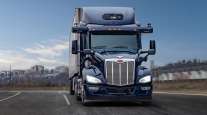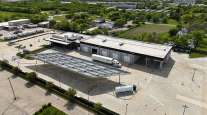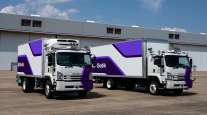Staff Reporter
Daimler Unwraps Autonomous, Electric Demonstration Truck
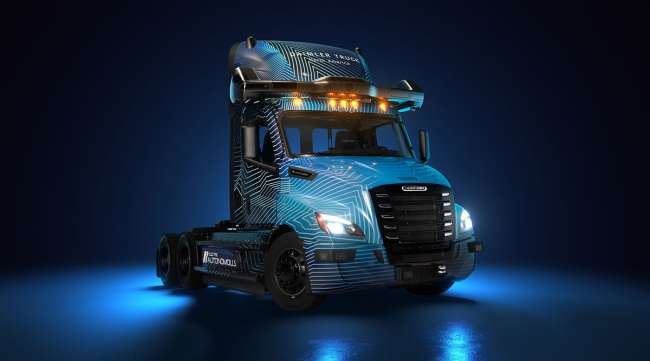
[Stay on top of transportation news: Get TTNews in your inbox.]
Daimler Truck unveiled plans May 8 to begin operating an autonomous, battery-electric Freightliner eCascadia demonstration truck.
The German original equipment manufacturer, which builds U.S. Class 8 Freightliner and Western Star trucks, said the tractor is based on a production battery-electric Freightliner eCascadia and equipped with Torc Robotics’ autonomous driving software plus Level 4 sensor and computing technology. Torc Robotics is Daimler Truck’s independent self-driving technology unit.
The demonstration vehicle is a 6x4 tractor equipped with a Detroit ePowertrain featuring a 438-kilowatt battery and producing 425 horsepower. It has an 82,000-pound gross vehicle weight rating and a 43,000-pound payload, Daimler Truck North America Director of Autonomous Driving Engineering Suman Narayanan said during a media preview.
Unlike prior Daimler Truck or Torc autonomous trucks, the eCascadia demonstrator is a day cab, offering a window into potential autonomous use cases, including shorter, repeatable routes with the use of zero-emission infrastructure, the company said. It has a range of up to 200 miles, and charging using dual connectors takes 90 minutes.
RELATED: Daimler Truck Q1 Profit Rises Even as Sales Fall
The Level 4 perception sensors comprise lidar, radar and cameras, Narayanan said. The demonstrator also will have a safety driver and a safety engineer in the cab. Sensors are located in the bumper and along an upper sensor bar located above the cab. The overall system is composed of 15 cameras, five lidar sensors, three short-range radar sensors, six long-range radar monitors and four ultra-long-range radar sensors. The upper sensor bar is designed for aerodynamic efficiency, Narayanan said.
For the first time, Daimler Truck combines two of the most promising future technologies: battery-electric and autonomous driving.
Say hello to our battery electric autonomous #Freightliner eCascadia technology demonstrator.🚛🔋🤖https://t.co/iu3rTIvZZp#DaimlerTruck pic.twitter.com/Klp8NGZ5kF — Daimler Truck (@DaimlerTruck) May 8, 2024
The autonomous computer system is located between the driver seat and passenger seat as well as under the passenger seat. The overall computer stack has a prototype cooling system, said Narayanan, along with a backup power system comprising four lead acid batteries behind the cab.
“By combining zero-emission and autonomous technologies in one product, we are testing solutions for challenges our customers are likely to face in the future,” DTNA CEO John O’Leary said in a statement.

O'Leary and Narayanan
“We want to give them choices that allow them to do what they do best: keep the world moving today and well into the future. That takes a lot of foresight, questioning, testing, learning, improving and co-creating with our customers years in advance to ultimately find the right solution. This truck is a great example of the beginning of that development process,” he added.
Currently, however, the truck cannot drive in autonomous mode, a spokeswoman said in response to Transport Topics questions. “Together with our partner Torc, we are exploring ways and next steps to enable our eCascadia autonomous technology demonstrator to drive in autonomous mode in the near future,” the spokeswoman told TT.
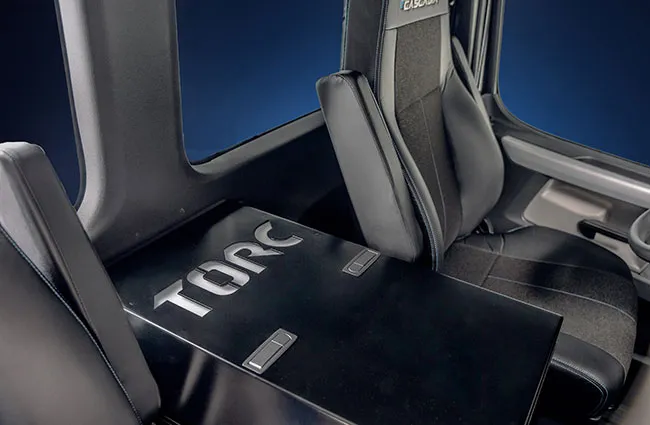
The Torc compute stack of the autonomous Freightliner eCascadia sits between the driver and engineer’s seats. (Daimler Truck)
The autonomous eCascadia is expected to be tested first in hub-to-hub applications, driving between freight centers along U.S. highway corridors. Joanna Buttler, Daimler Truck head of the global autonomous technology group, told reporters the first lanes will be in Texas between Laredo and Dallas. The autonomous program at Daimler Truck will focus on the southwestern U.S. initially, Buttler said, adding that the demonstration truck is the first step toward a zero-emission autonomous vehicle. “We want to make the trucking industry even better,” she said.
Buttler stressed that autonomous operations offer benefits to trucking. For fleets, they include better asset utilization and a way to address a shortage of drivers. For drivers, autonomous operations offer the potential for new job profiles and more time close to home, she said.
#newepisode: @torcrobotics CEO Peter Vaughan Schmidt and Joanna Buttler, head of @DaimlerTruck’s global autonomous technology group discuss the timeline for autonomous trucks entering the market and how they blend into existing fleet operations. Tune in: https://t.co/2jwXjQo9PC pic.twitter.com/MQy6I66FZB — RoadSigns Podcast (@ttroadsigns) January 5, 2024
Daimler Truck intends to start serial production of autonomous trucks, albeit with conventional engines, in 2027.
Torc has been testing autonomous-ready Freightliner Cascadia trucks since 2023 with carriers such as Schneider and C.R. England, including on a test route between Phoenix and Oklahoma City.
Schneider ranks No. 8 on the Transport Topics Top 100 list of the largest for-hire carriers in North America and No. 21 on the TT Top 100 largest logistics companies list. C.R. England ranks No. 28 on the for-hire TT100.
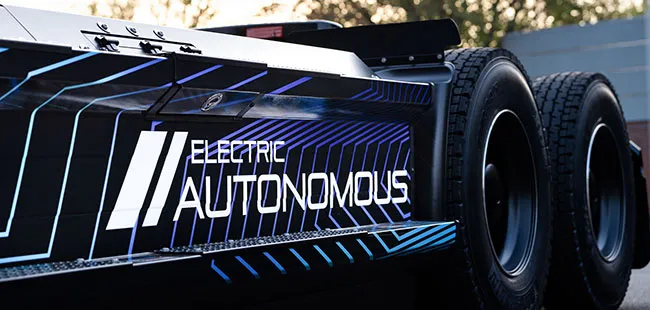
Daimler Truck intends to start serial production of autonomous trucks, albeit with conventional engines, in 2027. (Daimler Truck)
Looking forward, Daimler Truck is keeping its options open, with battery-electric, hydrogen fuel cell electric vehicles and internal combustion engines using hydrogen all as potential options down the line, executives said.
However, the company is not carrying out any work on a hydrogen FCEV autonomous demonstrator at the moment, Buttler said, adding that drivetrain options beyond conventional diesel and battery-electric systems were still in the learning and exploration stages.
Daimler Truck unveils autonomous Freightliner eCascadia
And while Daimler Truck has been developing and testing autonomous truck technology since 2015 — when the Freightliner Inspiration Truck was unveiled as the first licensed Level 2 autonomous commercial truck to operate on open public highways in the United States — reaching full autonomy is currently not on the slate for the truck maker.
Daimler Truck is focused on Level 4 autonomous trucking at the moment rather than looking into completely autonomous Level 5 vehicles, Narayanan said.
Want more news? Listen to today's daily briefing below or go here for more info:


